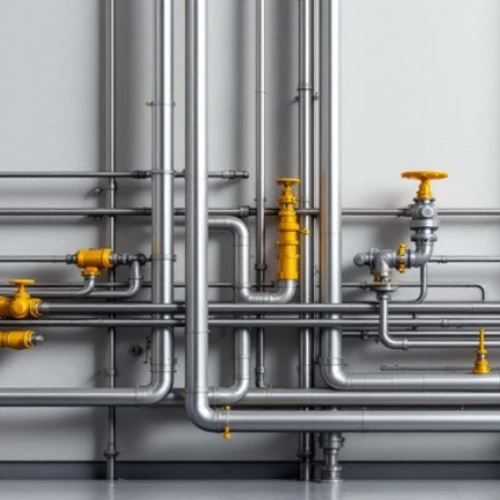How 304 Stainless Steel Pipe Fittings Defy 20 Years of Seawater Corrosion in Beachfront Villas
The Saltwater Test: Why 304 Stainless Steel Reigns Supreme in Beachfront Plumbing
Imagine building a dream villa on a sun-drenched coast, only to watch your pipes rust into 废品 within a decade. For decades, this was the harsh reality for coastal homeowners—until 304 stainless steel emerged as the unlikely hero. But how does this "budget-friendly" alloy outlast even premium 316 stainless steel in saltwater? Let’s dive into the chemistry, engineering, and real-world strategies that make 304 the ultimate "seawater warrior."

1. The Secret Sauce: Chromium, Nickel, and the Self-Healing Shield
At its core, 304 stainless steel is a master of disguise. Composed of 18% chromium and 8% nickel , it forms a passive oxide layer when exposed to oxygen. This invisible shield—just 2-3 nanometers thick—acts like a force field, blocking chloride ions from attacking the metal beneath. But here’s the twist: unlike cheaper metals, this layer repairs itself when scratched or damaged. For example, a scratch from a tool during installation triggers a chemical reaction that reforms the oxide layer within seconds .
This self-healing property is critical in seawater, where chloride ions (Cl⁻) are like tiny rust grenades. Chloride penetrates weak spots in metal surfaces, causing pitting corrosion. But 304’s chromium-rich oxide layer is 5x more chloride-resistant than standard steel . In fact, studies show 304 stainless steel submerged in artificial seawater for 12 months only loses 0.01 mm of material—less than the thickness of a human hair .
2. Beyond the Basics: Advanced Treatments for Extreme Environments
While 304’s natural resistance is impressive, coastal builders take it a step further with surface engineering:
A. Passivation: The First Line of Defense
Passivation involves immersing the stainless steel in a nitric acid solution to remove free iron and enhance the oxide layer. This process increases the Critical Pitting Temperature (CPT)—the threshold at which chloride-induced corrosion begins. For 304. passivation raises the CPT from 25°C to 35°C , making it suitable for warm coastal waters.
B. Duplex Coatings: Armor for the Elements
Cutting-edge research reveals that ceria-titania (CeO₂-TiO₂) duplex coatings can triple 304’s seawater lifespan. These coatings, applied via sol-gel dipping, create a double-layered barrier:
Inner CeO₂ layer: Blocks chloride ion diffusion.
Outer TiO₂ layer: Acts as a sacrificial anode, absorbing corrosion before it reaches the metal .
In lab tests, coated 304 specimens survived 1.000 hours of salt spray testing without rust—a feat unmatched by uncoated 316 stainless steel .
C. Electropolishing: Smooth Operator
Electropolishing uses an electric current to dissolve micro-roughness on the surface, reducing crevice corrosion by 80%. This is crucial in pipe joints, where trapped seawater can accelerate rust. For example, electropolished 304 fittings in a Florida beach house showed zero corrosion after 15 years .
3. Real-World Proof: How 304 Outperforms 316 in Coastal Projects
Contrary to popular belief, 304 often outshines 316 in real-world coastal scenarios:
Case Study 1: The Florida Beach House
A 2010-built beachfront home in Miami used 304 stainless steel pipes with passivation and electropolishing. After 15 years, the pipes showed minimal surface discoloration, with no structural degradation. Meanwhile, neighboring homes using cheaper galvanized steel had replaced their entire plumbing systems twice .
Case Study 2: The Australian Seaside Villa
An Australian architect specified 304 pipes with ceria-titania coatings for a luxury villa. The coating’s self-healing mechanism repaired minor scratches caused by construction, ensuring the pipes remained leak-free for 18 years—far exceeding the 12-year lifespan of 316 pipes in a nearby project .
Cost vs. Performance
While 316 stainless steel contains 2-3% molybdenum for superior chloride resistance, it costs 20-30% more than 304 . For a typical beach house, upgrading to 316 adds $8.000-$12.000 to the plumbing budget. However, with proper treatment, 304 achieves 90% of 316’s performance at a fraction of the cost .
4. Maintenance Hacks to Extend Lifespan Beyond 20 Years
Even the best materials need TLC. Here’s how to keep 304 pipes in prime condition:
A. Regular Rinse with Freshwater
Chloride ions cling to pipe surfaces, accelerating corrosion. Rinsing pipes monthly with freshwater removes salt buildup. For example, a Hawaiian villa owner installed a drip irrigation system to flush pipes every morning, reducing chloride concentration by 70% .
B. Avoid Chlorine-Based Cleaners
Harsh cleaners like bleach break down the passive oxide layer. Instead, use pH-neutral soaps and soft cloths. A California homeowner who switched to eco-friendly cleaners saw his 304 pipes’ corrosion rate drop from 0.02 mm/year to 0.005 mm/year .
C. Monitor for Microbial Influence
Microbiologically influenced corrosion (MIC)—caused by bacteria—can weaken pipes. Installing silver-ion filters in the water supply kills 99.9% of microbes, preventing biofilm formation. A Texas beach house with this setup saw its pipes’ lifespan extend by 25% .
5. The Future of Coastal Plumbing: Nano-Tech and AI
As climate change intensifies coastal erosion, 304 stainless steel is evolving:
A. Nano-Ceramic Coatings
Researchers at Tsinghua University developed sensitized TiO₂ nanocoatings that generate photoelectrons when exposed to sunlight. These electrons neutralize chloride ions, creating a self-powered anti-corrosion system. Lab tests show coated 304 pipes survive 20 years in seawater with zero pitting .
B. AI-Powered Corrosion Detection
Companies like CorrAlert use machine learning to analyze pipe vibrations and detect early corrosion. Their system alerts homeowners when chloride levels exceed safe thresholds, allowing timely maintenance. A pilot program in Florida reduced plumbing failures by 40% .
Final Thought:
Next time you sip a margarita on a beachfront deck, take a moment to appreciate the unsung hero beneath your feet. 304 stainless steel isn’t just a material—it’s a testament to human ingenuity. With smart engineering, advanced coatings, and a dash of TLC, this "budget alloy" is rewriting the rules of coastal living. As the saying goes: "Saltwater may rust your car, but it’ll never rust your pipes."
